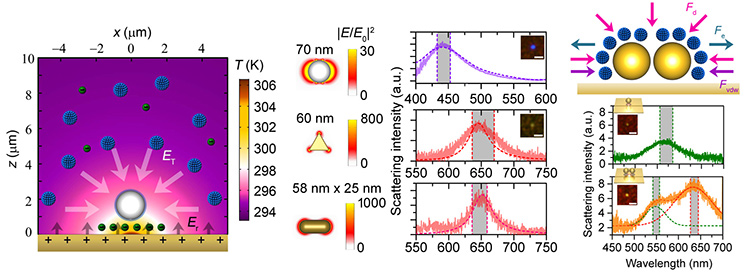 Left: Working principle of OTENT. Center: Opto-thermoelectric trapping of diverse metallic nanoparticles with single-particle resolution and in situ dark-field spectroscopic analysis. Right: Interparticle interaction and coupling between two gold nanoparticles in the thermoelectric field. [Enlarge figure]
Left: Working principle of OTENT. Center: Opto-thermoelectric trapping of diverse metallic nanoparticles with single-particle resolution and in situ dark-field spectroscopic analysis. Right: Interparticle interaction and coupling between two gold nanoparticles in the thermoelectric field. [Enlarge figure]
Optical manipulation of low-dimensional materials is important for applications in materials science and life science. Optical tweezers, which work by exerting an optical gradient force on a particle with refractive-index contrast relative to the surrounding medium, have proved an efficient optical instrument for remote and versatile manipulation of particles from micro- to nanoscale, as well as for trapping living biological cells.1 The importance of tweezers was highlighted by the 2018 Nobel Prize in Physics, half of which went to the method’s pioneer, Arthur Ashkin.
Yet optical tweezers also have limitations, related to their highly focused and intense laser beams, which can lead to radiation damage on the trapped objects. Specifically, the trapping of light-absorbing materials represents another challenge due to the strong thermal fluctuation and reduced trapping stability. Future applications thus will require technical innovation in low-power optical tweezing techniques.2,3 Recently, we have developed a new type of light-based tweezing, opto-thermoelectric nanotweezers (OTENT), to achieve low-power trapping, in situ analysis and assembly of a variety of colloidal nanoparticles.4
To drive OTENT, we begin by adding a cationic surfactant, cetyltrimethylammonium chloride (CTAC), to a suspension of nanoparticles. The self-assembly of CTAC molecules provides the macro-cations (CTAC micelles), while their counter-ions, Cl–, serve as the anions. The adsorption of CTAC molecules on the particle surface also unifies the surface charges, providing positive colloidal particles in the system.
Next, a laser is directed to heat a thermoplasmonic substrate and create a localized temperature field. Both the cations and anions undergo thermophoresis along the temperature gradient and build an electric field pointing from cold to hot, which holds the positive particles at the thermal hot spots. With the high-efficiency photon-to-phonon conversion, OTENT dramatically reduces the required operating power to 10–1 mW, about three orders of magnitudes lower than that for traditional optical tweezers.
Further incorporation of dark-field scattering spectroscopy into OTENT enables in situ identification of the colloidal particles, giving information such as colloidal material and particle size. Specifically, the thermophoresis of CTAC micelles provides a depletion force to tune the inter-particle coupling when multiple particles are trapped in the thermoelectric field. Besides optical trapping, we further demonstrated that OTENT can be utilized for on-demand assembly of a variety of colloidal matter with rich geometric configurations,5 which will find applications in functional colloidal devices.
The future optimization of OTENT will, we believe, open new avenues in optical nanofabrication, biosensing and optofluidics.
Researchers
Linhan Lin and Yuebing Zheng, University of Texas, Austin, Texas, USA
References
1. D.G. Grier. Nature 424, 810 (2003).
2. P.Y. Chiou et al. Nature 436, 370 (2005).
3. M. Righini et al. Nat. Phys. 3, 477 (2007).
4. L. Lin et al. Nat. Photon. 12, 195 (2018).
5. L. Lin et al. Sci. Adv. 3, E1700458 (2017).

